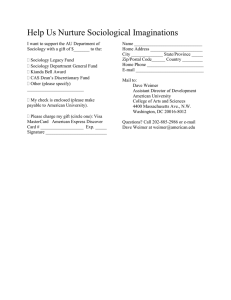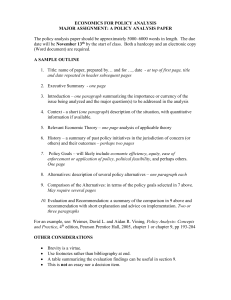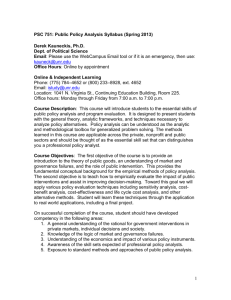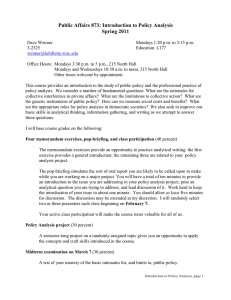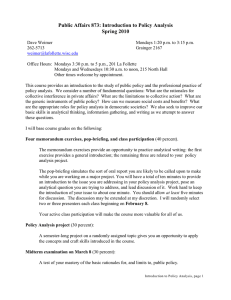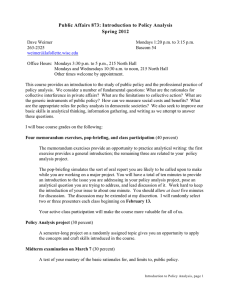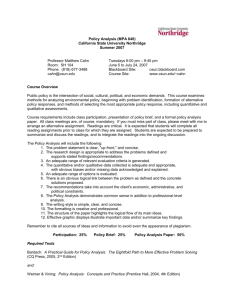6313 (1-16609) Fundamentals of Policy Analysis PUBL University of Houston
advertisement
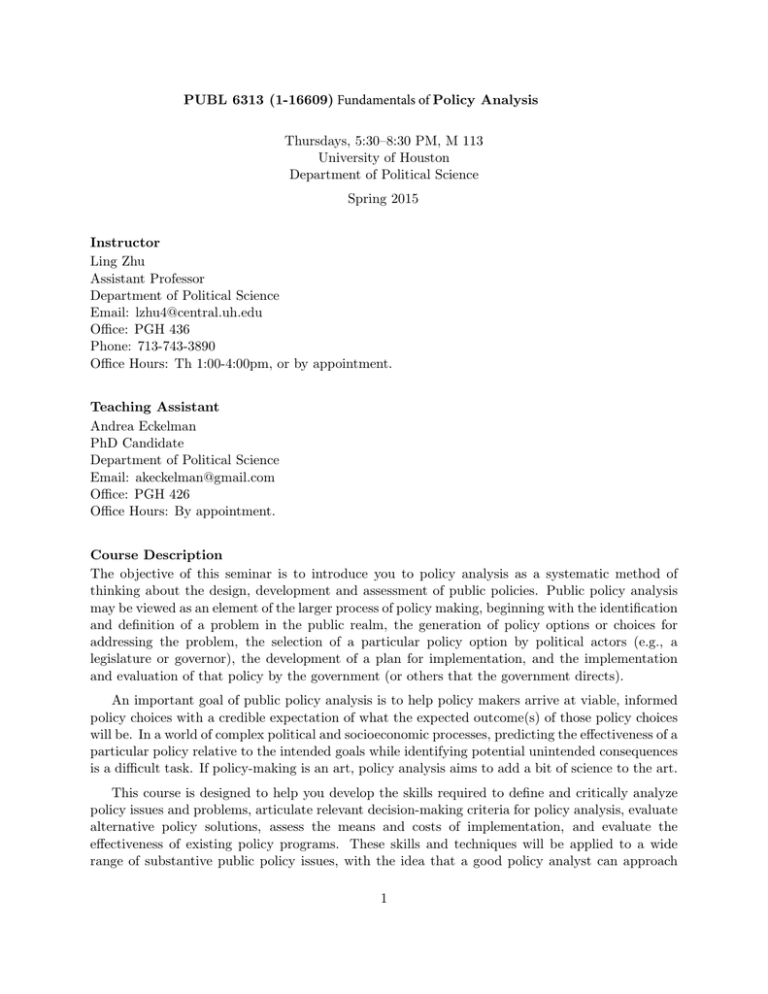
PUBL 6313 (1-16609) Fundamentals of Policy Analysis Thursdays, 5:30–8:30 PM, M 113 University of Houston Department of Political Science Spring 2015 Instructor Ling Zhu Assistant Professor Department of Political Science Email: lzhu4@central.uh.edu Office: PGH 436 Phone: 713-743-3890 Office Hours: Th 1:00-4:00pm, or by appointment. Teaching Assistant Andrea Eckelman PhD Candidate Department of Political Science Email: akeckelman@gmail.com Office: PGH 426 Office Hours: By appointment. Course Description The objective of this seminar is to introduce you to policy analysis as a systematic method of thinking about the design, development and assessment of public policies. Public policy analysis may be viewed as an element of the larger process of policy making, beginning with the identification and definition of a problem in the public realm, the generation of policy options or choices for addressing the problem, the selection of a particular policy option by political actors (e.g., a legislature or governor), the development of a plan for implementation, and the implementation and evaluation of that policy by the government (or others that the government directs). An important goal of public policy analysis is to help policy makers arrive at viable, informed policy choices with a credible expectation of what the expected outcome(s) of those policy choices will be. In a world of complex political and socioeconomic processes, predicting the effectiveness of a particular policy relative to the intended goals while identifying potential unintended consequences is a difficult task. If policy-making is an art, policy analysis aims to add a bit of science to the art. This course is designed to help you develop the skills required to define and critically analyze policy issues and problems, articulate relevant decision-making criteria for policy analysis, evaluate alternative policy solutions, assess the means and costs of implementation, and evaluate the effectiveness of existing policy programs. These skills and techniques will be applied to a wide range of substantive public policy issues, with the idea that a good policy analyst can approach 1 problems as a generalist and bring more specific information from a given policy area to bear in the analysis. Prerequisites There are no prerequisites. We will use R for problem sets and data analysis examples. Replication code, datasets, and detailed lab instructions will be distributed on Blackboard Learn each week before seminar session. Learning Objectives 1. To become familiar with the core concepts related to the policymaking process. 2. To become familiar with the tools that scholars use to analyze public policy. 3. To learn the statistical skills of policy analysis, including descriptive analysis, cost-benefit analysis, impact analysis, and data visualization. Required Books and Additional Readings 1. Weimer, David L. and Aidan R. Vining. 2011. Policy Analysis, 5th edition. Longman. 2. Gupta, Dipak K. 2012. Analyzing Public Policy: Concepts, Tools, and Techniques, 2nd edition. CQ Press. 3. There are additional weekly readings and methodology handouts to be distributed on Blackboard Learn. 4. Recommended Books for R: • Fox, John and Sanford Weisberg. 2011.An R Companion to Applied Regression, 2nd edition.Sage Publication. • Teetor, Paul. 2011. R Cookbook. O’Reilly. Course Requirements 1. Class attendance and participation in class discussion. 2. Read the assigned readings prior to each class meeting. 3. Problem Sets. Through the semester, you will be given 5 open-book problem sets in total (starting from Week 4). Each problem set contains 2-3 policy analysis questions, which are designed to help you learn and practice a specific policy analysis skill. The problem sets are also designed to prepare students for comprehensive exam questions pertaining to policy analysis. Each problem set will be distributed on Thursday in class and due on Wednesday noon the following week, on Blackboard. We will use a subsequent class to discuss each problem set. 4. A term paper. You are required to write a term paper through the semester. There are two options for writing the term paper. 2 • Option 1: A policy analysis report. The policy analysis report should explicitly address one policy problem, describe that problem with empirical data, and contain an analytical component comparing policy alternatives used to address the policy problem (see Gupta Appendix A and B as examples). • Option 2: A research paper. You can also choose to write a research paper that is related to a public policy topic of interest. The research paper should explicitly address one research question, review the recent and most relevant literature, and contain an analytical component using empirical data to address the research question. The research paper should follow the APSA style. The term paper should not be shorter than 4,000 words (including references, figures and statistical tables). You CANNOT use any of your term papers from other seminars for this class. A duplicate submission will be deemed as self-plagiarism, and will automatically receive a grade of F. The term paper assignment is divided into several segments to allow students develop their papers step by step through the semester, and to obtain feedback on each section. • February 5 (optional), noon: Part 1 (2-page introduction) due by email. • March 5 (optional), noon: Part 2 (5-page literature review and/or research design) due by email. • April 2 (optional), noon: Part 3 (6-page data analysis research design and data analysis) due by email. • April 30 (required), noon: first paper draft due on Blackboard learn. • May 10 (required), noon: final paper due on Blackboard Learn. 5. Mini-Conference. We will hold two mini-conference sessions on April 30 and May 7, respectively. Each student will have 10 minutes to present his/her term paper to the class and to draw feedback from the audience. Attendance and Late Policy 1. Attendance. Absence from the class will only be accepted in extenuating circumstances with a university-accepted excuse. If you know in prior that you cannot attend the class, please inform me before the scheduled class-meeting. 2. Late Policy. Late work will be penalized by one letter grade. E.g. an A-paper turned in one day late will become a B-paper. Late work would only be accepted without grade-penalty if you have university-accepted excuses. Grading 1. Participation, 10% 2. Problem sets, 40%. 3. Term paper, 40% 4. Mini-Conference Presentation, 10% 3 5. Final A AB+ B BC+ C CD+ D DF Grades = 100-95 (Excellent) = 94-90 = 89-87 (Good) = 86-84 = 83-80 (Poor) = 79-77 = 76-74 = 73-70 = 69-67 = 66-64 = 63-60 = 59-0 (Failing) Academic Integrity As commonly defined, presenting the words or works of others’ as your own is plagiarism. Plagiarism is one of the worst academic sins, for the plagiarist destroys the trust among colleagues, without which research cannot be safely communicated. Plagiarism is also a violation of the UH Academic Honesty Policy. If you are uncertain of what constitute academic dishonesty, you should contact me prior to submitting the assignment and/or check the UH Academic Honesty Policy from the university website: www.uh.edu/provost/policies/uhhonestypolicy.html. Students are expected to adhere to the UH Academic Honesty Policy. Cheating or plagiarism in course assignments, exams, and the final paper will lead to a grade of F. Americans with Disability Act (ADA) The Americans with Disabilities Act (ADA) is a federal anti-discrimination statute that provides comprehensive civil rights protection for persons with disabilities. Among other things, this legislation requires that all students with disabilities be guaranteed a learning environment that provides for reasonable accommodation of their disabilities. If you believe you need special accommodations and assistance due to a disability, please contact the Center for Students with DisABILITIES (CSD Building 568, Room 110) and the Learning Support Services (LSS, 321 Social Work Building), or call 713-743-5411 to make appropriate arrangements. Course Calendar PART I. Understanding the Basics of Policy Analysis Week 1 (January 22): Course Overview Week 2 (January 29): Introduction to Public Policy Analysis • Weimer & Vining, Chapter 1-2. • Gupta, Chapter 1-2. 4 • Lasswell, Harold D. 1970.“The Emerging Conception of Policy Sciences.” Policy Sciences 1(1): 3-30. • Wildavsky, Aaron. 1973.“If Planning is Everything, Maybe Its Nothing.” Policy Sciences 4(2): 127-153. • Adams, William C., Donna Lind Infeld, Laura F. Minnichelli, and Michael W. Ruddell. 2014. “Policy Journal Trends and Tensions: JPAM and PSJ.” Policy Studies Journal 42(s1): s118-s137. • Lab 1: Getting Start on R – Installing R and RStudio – Data manipulation in R Week 3 (February 5): The Policy Analysts: Their Roles and Their Tools • Weimer and Vining, Chapter 3 • Gupta, Chapter 2, 4-5 • Waldo, Dwight. 1952.“Development of Theory of Democratic Administration.” American Political Science Review 46(1): 81-103. • Simon, Herbert, Peter F. Drucker, and Dwight Waldo. 1952.“‘Development of Theory of Democratic Administration: Replies and Comments”. American Political Science Review 46(2): 494-503. • Jenkins-Smith,Hank. 1982. “Professional Roles for Policy Analysts: A Critical Assessment.” Journal of Policy Analysis & Management 2(1): 88-100. • Harmon, Michael M. 1989. “The Simon/Waldo Debate: A Review and Update.” Public Administration Quarterly 12(4): 437-451. • Barke, Richard, Hank Jenkins-Smit, and Paul Slovic. 1997. “Risk Perceptions of Men and Women Scientists.” Social Science Quarterly 78(1): 167-176. • Lab 2: Graphical Tools in R – Package lattice and ggplot2 PART II. Conceptual Foundations for Problem Analysis Week 4 (February 12): Market Failure and Inefficiency • Weimer and Vining, Chapter 4-5 • Gupta, Chapter 3 (pp.49-61) • Akerlof, Geroge A. 1970.“The Market for ‘Lemons’: Quality Uncertainty and the Market Mechanism.” The Quarterly Journal of Economics 84(3): 488-500. • Blomquist, William and Elinor Ostrom. 1985.“Institutional Capacity and the Resolution of a Common Dilemma.” Policy Studies Review 5(2): 283-293. • Vining, Aidan R. and David L. Weimer. 1988. “Information Asymmetry Favoring Sellers: A Policy Framework.” Policy Sciences 21(4): 281-303. 5 • Sandler, Todd and Daniel G. Arce. 2002. “A Conceptual Framework for Understanding Global and Transnational Public Goods for Health.” Fiscal Studies 23(2): 195-222. • Gupta, Chapter 6 • Lab 3: Descriptive Analysis (1) – – – – – Sampling from a population Analyzing central tendency Analyzing dispersion Describing the distribution Distribute Problem Set 1 Week 5 (February 19): Other Limitations of the Competitive Framework • Discuss Problem Set 1 • Weimer and Vining, Chapter 6 • Gupta, Chapter 3 • Meier, Kenneth J. 1999. “Drugs, Sex, Rock and Roll: A Theory of Morality Politics.” Policy Studies Journal 27(4): 681-695. • Whitford, Andrew B. 2007.“Designing Markets: Why Competitive Bidding and Auctions in Government Often Fail To Deliver.” Policy Studies Journal 35(1): 61-85. • Weimer, David, Aidan R. Vinin and Randall K. Thomas. 2009. “Cost-Benefit Analysis Involving Addictive Goods: Contingent Valuation to Estimate the Willingness-to-Pay for Smoking Cessation.”Health Economics 18(2):181-202. • Zhu, Ling, 2015. “Measurement Approaches in Public Administration Surveys.” In Encyclopedia of Public Administration and Public Policy, 3rd edition, forthcoming. • Gupta, Chapter 9 • Lab 4: Descriptive Analysis (2): Measurement – – – – – – Measuring social inequality Standardization Ranking Indexing: factor analytical models Item-response theory (IRT) models Distribute Problem Set 2 Week 6 (February 26): Government Interventions and Unintended Consequences • Weimer and Vining, Chapter 7-8 • Guest Speaker: Francisco Pedraza (Texas A&M University) Week 7 (March 5): Limits to Government Interventions: Government Failures • Stigler, George. 1971. “The Theory of Economic Regulation.” The Bell Journal of Economics and Management Science 2(1): 3-21. 6 • Weimer, David L. 1980. “Federal Intervention in the Process of Innovation in Local Public Agencies: A Focus on Organizational Incentives.” Public Policy 28(1): 83-116. • Bohte, John and Kenneth J. Meier. 2000. “Goal Displacement: Assessing the Motivation for Organizational Cheating.” Public Administration Review 60(2): 183-182. • Carpenter, Daniel P. 2004. “Protection without Capture: Product Approval by Politically Responsive, Learning Regulator.” American Political Science Review 98(4): 613-634. • Erler, H. Abbie. 2007. “Legislative Term Limits and State Spending.” Public Choice 133: 479-494. • Miller, Susan M., Jill Nicholeson-Crotty and Sean Nicholeson-Crotty. 2011. “Reexaming the Institutional Effects of Term Limits in U.S. State Legislatures.” Legislative Studies Quarterly 36(1): 71-97. • Discuss Problem Set 1-2. PART III. Analyzing Policy Solutions Week 8 (March 12): Correcting Market and Government Failure • Weimer and Vining: Chapter 10 • MacCoun, Robert J., Peter Reuter, and Thomas Schelling. 1996. “Assessing Alternative Drug Control Regimes.” Journal of Policy Analysis and Management 15(3): 330-352. • Kiser, Edger and Kathryn Baker. 2005. “Could Privatization Increase the Efficiency of Tax Administration in Less Developed Countries?” Policy Studies Journal 22(3): 489-500. • Fleming, David. 2014. “Learning from Schools: School Choice, Political Learning, and Policy Feedback.” Policy Studies Journal 42(1):55-78. • Lab 5: Probability and Measures of Uncertainty – – – – Probability distribution Correlations Hypothesis testing Distribute Problem Set 3 Week 9 (March 19): Spring Break. Week 10 (March 26): Policy Adoption and Implementation • Weimer and Vining, Chapter 11-12 • Gupta, Chapter 10-11 • O’Toole, Laurence J. Jr. 1986. “Policy Recommendations for Multi-Actor Implementation: An Assessment of the Field.” Journal of Public Policy 6(2): 181-210. • Meyers, Marcia K., Bonnie Glaser, and Karin McDonald. 1998. “On the Front Lines of Welfare Delivery: Are Workers Implementing Policy Reforms?” Journal of Policy Analysis and Management 17(1): 1-22. 7 • Gallo Nick and David Lewis. 2012. “The Consequences of Presidential Patronage for Federal Agency Performance.” Journal of Public Administration Research and Theory 22(2): 219-243. • Guest Speaker: Francisco Pedraza (Texas A&M University) PART V. Design and Develop Policy Analysis Week 11 (April 2): Cost-Benefit Analysis • Weimer and Vining, Chapter 13, 16. • Gupta, Chapter 14. • Lewis, David. 2002. “The Politics of Agency Termination: Confronting the Myth of Agency Immortality.”Journal of Politics 64(1): 89-107. • Daley, Dorothy M. and David F. Layton. 2004. “Policy Implementation and the Environmental Protection Agency: What Factors Influence Remediation at Superfund Sites?” Policy Studies Journal 32(3):375-392. • Boardman, Anthony, Aidan Vining andW. G. Waters II. 2007. “Costs and Benefits through Bureaucratic Lenses: Example of a Highway Project.” Journal of Policy Analysis & Management 12(3): 532-555. • Krutilla, Kerry and John D. Graham. 2012. “Are Green Vehicles Worth the Extra Cost? The Case of Diesel-Electric Hybrid Technology for Urban Delivery Vehicles.” Journal of Policy Analysis & Management 31(3): 501-532. • Stewart, Mark G. and John Mueller. 2013. “Aviation Security, Risk Assessment, and Risk Aversion for Public Decisionmaking.” Journal of Policy Analysis & Management 32(3):615-633. • Discuss Problem Set 3. Week 12 (April 9): Evaluate Policy Impact (1) • Gupta, Chapter 12. • Lewis, David. 2006. “Does Performance Budgeting Work? An Examination of the Office of Management and Budget’s PART Scores.”Public Administration Review 66(5): 742-752. • Srithongrung, Arwiphawee and Kenneth A. Kriz. 2014. “The Impact of Subnational Fiscal Policies on Economic Growth: A Dynamic Analysis Approach.” Journal of Policy Analysis & Management 33(4): 912-928. • Baccini, Leonardo, Quan Li, and Irina Mirkina. 2014. “Corporate Tax Cuts and Foreign Direct Investment.” Journal of Policy Analysis & Management 33(4): 977-1006. • Soledad Artiz Prillaman and Kenneth J. Meier. 2014. “Taxes, Incentives, and Economic Growth: Assessing the Impact of Pro-business Taxes on U.S. State Economies.” Journal of Politics 76(2):364-379. • Lab 6: Analyzing Policy Effects with Static and Dynamic Data – Cost-benefit ratio 8 – – – – – – – – Discounting Cost-benefit effective analysis Calculating expected utilities Regression models with dynamic data Impact analysis Single-factor projection Calculating short- and long-run effects using time-series data Distribute Problem Set 4. Week 13 (April 16): Work on term paper, no in-class meeting. Week 14 (April 23): Evaluate Policy Impact (2) • Gupta, Chapter 13 • Meier, Kenneth J. and Jeff Gill. 2000. What Works: A New Approach to Program and Policy Analysis. Westview. • Ling Zhu and Meredith B.L. Walker. 2013. “ ‘Too Much Too Young:’ Race, Descriptive Representation, and Heterogeneous Policy Responses in the Case of Teenage Childbearing.” Politics, Groups, and Identities, 1(4): 528-546. • Weiss, Michael J., Howard S. Bloom, and Thomas Brock. 2014. “A Conceptual Framework for Studying the Sources of Variation in Program Effects.” Journal of Policy Analysis &Management 33(3): 778-808. • Pierce, Jonathan J., Saba Siddiki, Michael D. Jones, Kristin Schumacher, Andrew Pattison and Holly Peterson. 2014. “Social Construction and Policy Design: A Review of Past Applications.” Policy Studies Journal, 42(1): 1-29. • Lab 7: Heterogeneity and the Analysis of Success and Failures – – – – Regression discontinuity design Population subgroups and heterogeneous effects Substantively weighted analytical techniques (SWAT) Discuss Problem Set 4. Week 15 (April 30): Mini-Conference, Session 1. Week 16 (May 7): Mini-Conference, Session 2. Caveat The aforementioned weekly schedule and assignments in this course may be subject to change. 9
